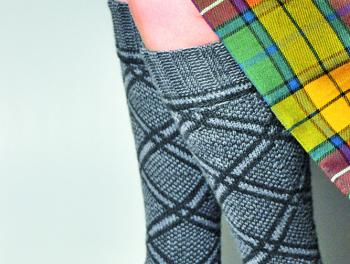This knitted pattern, which was unique to Gairloch, developed in the middle of the 19th century. At the time of the potato famine in the 1840s, strenuous efforts were made by the lairds of Gairloch to provide work for the people. To provide an income for the women, knitting was encouraged using wool from local fleeces, home spun and dyed with local plants taking advantage of the skills which many already possessed. To instruct them to a higher standard Lady Mackenzie of Gairloch employed an expert in spinning. A letter written in 1847 to the Destitution Board in Edinburgh states that Lady Mackenzie ‘has got above 100 women employed spinning wool who work up about 35 stones per week which is then knitted into stockings or woven into cloth.’ For the rest of her long life Lady Mary held exhibitions of yarns and stockings to promote the Gairloch home industry and gave prizes. It has been estimated that the annual value of the exports from the area was at least £500 by the end of the century. Towards the end of the nineteenth century a national ‘Home Industry’ Society was established.
Many patterns were used but one design in particular was favoured. This ‘Gairloch pattern’ was used for stockings in the main but was also widely applied to waistcoats and other garments. Normally employing two shades of wool, the pattern could be more elaborately coloured but the design remained standard. It is still known to and used by older residents. You can see some examples on display at Gairloch Heritage Museum.
In 2015, as part of the Museums Galleries Scotland sponsored Festival of Museums, volunteers at Gairloch Heritage Museum revived the pattern and published a modern knitting pattern for kilt stockings in the Gairloch Pattern, which is available from the museum and other local shops in Gairloch. It can also be purchased on the Ravelry knitters website.

